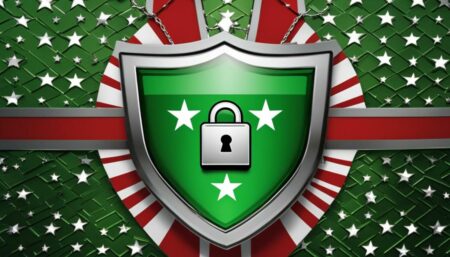Website security is a top priority for anyone running a website. SSL/TLS certificates help secure communication between the website and its users by providing data encryption, data integrity, and authentication. The common name is an essential part of the SSL/TLS certificate, and understanding its role is crucial for a secure certificate setup.
Key Takeaways
- SSL/TLS certificates provide data encryption, data integrity, and authentication for websites.
- The common name is an essential part of the SSL/TLS certificate.
- Understanding the basics of SSL/TLS protocols, public and private keys, and the role of digital certificates is essential for a secure SSL certificate setup.
Understanding SSL/TLS Protocols and Public/Private Keys
SSL/TLS provides data encryption, data integrity, and authentication to ensure that data transmitted between a web server and a client is private and secure. SSL/TLS protocols work by encrypting data and using public and private keys for message signing.
Public and private keys are used for encryption and signing messages. The public key is used to encrypt data, while the private key is used to decrypt it. The private key is kept secret, while the public key is shared with others.
SSL/TLS certificates establish trust by linking a public key to an entity verified by a certificate authority. A digital certificate contains information about the website owner, including the common name, organization name, and location. It also contains the public key and the digital signature of the certificate authority.
To obtain a digital certificate, one needs to submit a certificate request to a recognized certificate authority. The request contains the website owner’s information and the public key. The certificate authority verifies the owner’s identity and issues a digital certificate.
Installing the SSL certificate on a Windows Server 2016 involves creating a certificate signing request (CSR) and then installing the certificate. The CSR contains the website owner’s information and the public key. The certificate authority verifies the information and issues a digital certificate, which can then be installed on the server.
It’s important to note that the common name on the SSL certificate must match the domain it is installed on. If there is a mismatch, the browser will display the NET::ERR_CERT_COMMON_NAME_INVALID error, which indicates that the SSL certificate is not trusted.
To resolve this issue, verify the SSL certificate to ensure it was issued by a trusted certificate authority. You should also ensure that the common name on the certificate matches the domain it is installed on.
Conclusion
Understanding SSL/TLS protocols, public and private keys, and digital certificates is essential for a secure SSL certificate setup. Proper installation and verification of the certificate helps to avoid errors like the NET::ERR_CERT_COMMON_NAME_INVALID. Take the necessary steps to ensure that your SSL certificate is validated and installed correctly to ensure optimal website security.
Establishing Trust with SSL/TLS Certificates
SSL/TLS certificates establish trust by linking a public key to an entity verified by a certificate authority. These certificates are important for website security, as they ensure that the connection between the web server and the user’s browser is encrypted and secure. The certificate serves as a website security certificate, allowing users to trust that the website they are visiting is legitimate and not a fake site created by hackers.
A digital certificate is a digital file that is used to verify the authenticity of a website. It contains information about the website owner, the public key associated with the website, and the certificate itself. When a user visits a website that is secured with SSL/TLS, the web server provides the user’s browser with the website’s SSL certificate.
To ensure that the SSL certificate is genuine, the certificate authority verifies the identity of the website owner before issuing the certificate. This verification process ensures that the website owner has the right to use the domain name associated with the SSL certificate. Once the certificate authority has verified the website owner’s identity, they digitally sign the SSL certificate, providing assurance that the website is legitimate and secure.
Obtaining a Digital Certificate
To obtain a digital certificate, one needs to submit a certificate request to a recognized certificate authority. This request contains information about the entity or individual requesting the certificate and the public key that will be included in the certificate. The certificate authority verifies this information before issuing the certificate to ensure that the public key is linked to a legitimate and verified entity.
Before submitting a certificate request, ensure that the entity or individual has the legal right to use the domain name listed on the certificate. The certificate authority may require proof of domain ownership or authorization from a legal representative to issue the certificate.
Certificate requests can be submitted through a certificate management tool or by using a command-line interface. The certificate authority may also require additional information or documentation to complete the verification process. Once the certificate is issued, it can be installed on the server or device where it will be used.
Installing an SSL Certificate on Windows Server 2016
Installing the SSL certificate on a Windows Server 2016 involves creating a certificate signing request (CSR) and then installing the certificate. First, log in to the Windows server and open Internet Information Services (IIS) Manager.
Next, select the server name and then double-click on ‘Server Certificates’. Click on ‘Create Certificate Request’ from the right-hand actions menu.
Fill out the required information fields including the common name, which should match the domain name. Select the key bit length (2048 is recommended) and the algorithm. Save the CSR to a text file.
Submit the CSR to a recognized certificate authority such as DigiCert, GlobalSign, or Verisign. The certificate authority will verify the entity requesting the certificate and then issue a digital SSL certificate.
Once the certificate is issued, download it and install it on the Windows Server. Return to IIS Manager and select the server name. Double-click on ‘Server Certificates’ and then click on ‘Complete Certificate Request’ from the right-hand actions menu.
Browse for the SSL certificate file and enter a friendly name to identify the certificate. Click ‘OK’ and the SSL certificate will be installed on the Windows Server.
Summary:
Obtaining and installing an SSL certificate on a Windows Server 2016 involves creating a certificate signing request (CSR), submitting it to a certificate authority, and then installing the issued digital certificate onto the server. By following these steps, you can ensure a secure setup of your SSL certificate on your Windows Server.
Common Issues: NET::ERR_CERT_COMMON_NAME_INVALID
The NET::ERR_CERT_COMMON_NAME_INVALID error occurs when there is a mismatch between the common name on the SSL certificate and the domain it is installed on. This can happen if the SSL certificate is not configured properly or if the common name is not specified correctly.
When this error occurs, users will see a warning message in their browser indicating that the SSL certificate is not trusted and that it may be unsafe to proceed. This can be a significant concern, as users may be hesitant to continue using the website if they are unsure whether their data is being transmitted securely.
Fortunately, there are steps that can be taken to resolve the NET::ERR_CERT_COMMON_NAME_INVALID error and ensure that the SSL certificate is configured correctly. One of the first steps that should be taken is to verify the SSL certificate to ensure that it has been issued properly and that the common name is correct.
Verifying the SSL Certificate
Verifying the SSL certificate involves checking the details of the certificate to ensure that it has been issued properly and that the common name is correct. This can be done by opening the SSL certificate in your browser or by using an online SSL checker tool.
If the SSL certificate was not issued properly or if the common name is incorrect, you may need to contact your certificate authority to have the issue resolved. In some cases, you may need to reissue the SSL certificate with the correct information or request a new SSL certificate altogether.
Ensuring the Common Name Matches the Domain
Another common cause of the NET::ERR_CERT_COMMON_NAME_INVALID error is when the common name on the SSL certificate does not match the domain it is installed on. To ensure that the common name matches the domain, you will need to check the details of the SSL certificate and ensure that the common name matches the domain name exactly.
If the common name does not match the domain, you may need to request a new SSL certificate with the correct information or update the common name on the existing SSL certificate. In some cases, you may also need to update the DNS settings for the domain to match the common name on the SSL certificate.
By taking these steps, you can resolve the NET::ERR_CERT_COMMON_NAME_INVALID error and ensure that your SSL certificate is configured correctly. This will help to ensure that your website is secure and that users can trust that their data is being transmitted safely and securely.
Resolving the NET::ERR_CERT_COMMON_NAME_INVALID Error
Resolving this issue involves verifying the SSL certificate and ensuring that the common name matches the domain. The common name is an essential component of any SSL certificate that is used to secure your website. The common name should reflect the fully qualified domain name (FQDN) of your website, including the subdomain, if applicable.
If you receive the NET::ERR_CERT_COMMON_NAME_INVALID error, it indicates that the common name on the SSL certificate does not match the domain you are trying to access. This can happen when the SSL certificate is not properly installed, or when the common name of the SSL certificate is not configured correctly.
Verifying the SSL Certificate
The first step in resolving this error is to verify the SSL certificate. You can do this by clicking on the padlock icon in the address bar of your browser. This will display the SSL certificate information, including the common name. Verify that the common name matches the domain of your website.
If the common name does not match the domain of your website, you will need to obtain a new SSL certificate with the correct common name. You can contact your SSL certificate provider for assistance with obtaining a new SSL certificate.
Ensuring that the Common Name Matches the Domain
If the common name on the SSL certificate is correct, but you are still receiving the NET::ERR_CERT_COMMON_NAME_INVALID error, it is possible that the SSL certificate is not installed correctly. Verify that the SSL certificate is installed correctly and that the correct certificate is being used.
Make sure that the SSL certificate is installed on the correct server and that the certificate is associated with the correct domain. If you are using a shared hosting provider, check with them to ensure that the SSL certificate is installed correctly and that it is associated with the correct domain.
By verifying the SSL certificate and ensuring that the common name matches the domain, you can resolve the NET::ERR_CERT_COMMON_NAME_INVALID error and ensure that your website is secure for your visitors.
Conclusion
In conclusion, understanding the common name for an SSL certificate is crucial for a secure and efficient setup. SSL/TLS protocols provide data encryption, data integrity, and authentication for websites. Public and private keys are used for encryption and signing messages. SSL/TLS certificates establish trust by linking a public key to an entity verified by a certificate authority. To obtain a digital certificate, one needs to submit a certificate request to a recognized certificate authority.
Installing the SSL certificate on a Windows Server 2016 involves creating a certificate signing request (CSR) and then installing the certificate. However, common issues such as the NET::ERR_CERT_COMMON_NAME_INVALID error can occur when there is a mismatch between the common name on the SSL certificate and the domain it is installed on.
Resolving the NET::ERR_CERT_COMMON_NAME_INVALID Error
Resolving the NET::ERR_CERT_COMMON_NAME_INVALID error involves verifying the SSL certificate and ensuring that the common name matches the domain. This can be done by double-checking the certificate details and the domain name on the website. It’s also important to make sure that the certificate is issued by a trusted certificate authority and that the certificate is not expired.
Overall, by following these tips and understanding the importance of the common name for SSL certificates, website owners can ensure a secure and efficient setup for their website.
FAQ
Q: What is the common name on an SSL certificate?
A: The common name on an SSL certificate is the domain name for which the certificate is issued. It is used to verify that the SSL certificate belongs to the correct entity.
Q: How does an SSL/TLS certificate establish trust?
A: An SSL/TLS certificate establishes trust by linking a public key to an entity that has been verified by a certificate authority. This allows users to trust that the website they are connecting to is authentic and secure.
Q: How can I obtain a digital certificate?
A: To obtain a digital certificate, you need to submit a certificate request to a recognized certificate authority. The certificate authority will then verify your identity and issue the certificate.
Q: How do I install an SSL certificate on Windows Server 2016?
A: To install an SSL certificate on Windows Server 2016, you need to create a certificate signing request (CSR) and then install the certificate using the server’s certificate management tools.
Q: What is the NET::ERR_CERT_COMMON_NAME_INVALID error?
A: The NET::ERR_CERT_COMMON_NAME_INVALID error occurs when there is a mismatch between the common name on the SSL certificate and the domain it is installed on. This can happen when the certificate is issued for a different domain or subdomain than what is being accessed.
Q: How can I resolve the NET::ERR_CERT_COMMON_NAME_INVALID error?
A: To resolve this error, you need to verify the SSL certificate and ensure that the common name matches the domain you are trying to access. This may involve obtaining a new certificate with the correct common name or adjusting the domain configuration to match the certificate.





